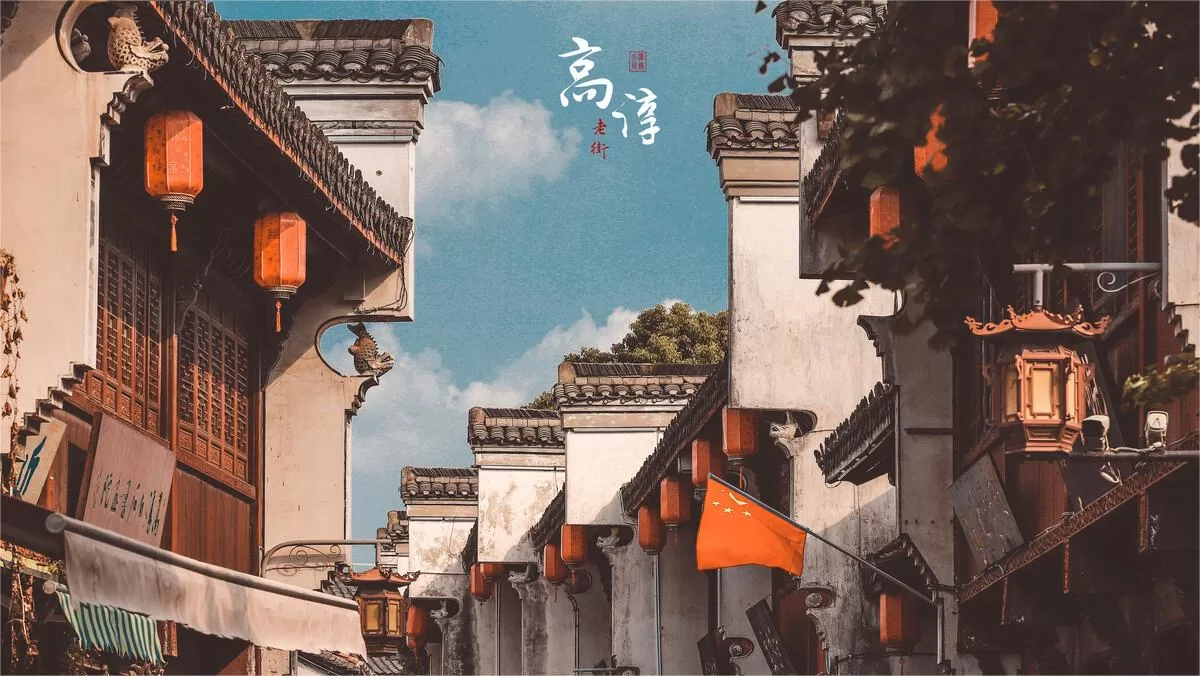Gaochun Old Street (高淳老街), situated to the south of Nanjing at the border of Jiangsu and Anhui provinces, is a prominent commercial street in the ancient town of Chunxi. With roots dating back to the Song Dynasty, this historical street has stood for over 900 years and is one of the best-preserved Ming and Qing Dynasty streets in Jiangsu Province.
The charming old street is paved with pink rouge-stone in the center and blue stone slabs on the sides. Flanked by rows of shops housed in traditional white-walled, black-tiled buildings, the two-story structures showcase wooden facades. While wandering down the ancient street, one cannot help but admire the delicate wood carvings under the eaves and the elegant black-and-white floral patterns beneath the horsehead walls. On rainy days, the street becomes even more enchanting, with rainwater glistening on the smooth stone roads and wooden facades taking on a deeper color than on sunny days.
Table of Contents
- Basic Information
- Location and Transportation
- Highlights of Gaochun Street
- Vlog about Gaochun Old Street
Basic Information
| Website | http://www.njgclj.cn/ |
| Estimated Length of Tour | 2 hours |
| Ticket Price | The street is free for entry. But you need to pay 40 RMB for the various attractions. |
| Opening Hours | 24 hours a day, but most attractions on the street operate from 9.00 to 17.00 |
| Telephone Number | 0086-025-57330757 |
Location and Transportation
Gaochun Old Street is located in Gaochun District, which is to the south of Nanjing’s urban area, nestled amidst picturesque mountains and surrounded by lush greenery. To get there, you can choose the following ways:
Bus: Take bus Gaochun 106 or Gaochun 108 and get off at Gaochun Old Street Stop (高淳老街站).
Metro: The nearest metro station to Gaochun Old Street is Gaochun (高淳) on line S9. After getting out of the station, transfer to bus Gaochun 105 to cover the remaining 4 kilometers.
Highlights of Gaochun Street
Yang Hall: A Mansion with History

Originally the residence of Zhao Dongyang, the “Pastry King” of Gaochun Old Street, Yang Hall was later sold to the Yang family and renamed “Yang Hall.” Constructed in the early years of the Republic of China, this three-sectioned mansion spans an area of over 500 square meters. The front entrance follows a distinctive gate-style design, featuring a covered corridor above the door and eaves with curved edges that serve both as rain protection and shade. The sidewalls gradually extend outward in stepped levels, adorned with motifs such as Iron Crutch Li, peonies, and symbols of good fortune. Inside, each hall has stone thresholds, with the height increasing symbolically from one to the next, representing progress and elevation in life and business.
Local Delicacies

Gaochun Old Street is not just a feast for the eyes but also a haven for food enthusiasts. Indulge in the local specialties that include fragrant tofu, the aromatic “Thousand-Mile Drifting Tofu,” traditional pastries, savory goose, garlic vegetables, and the renowned Old Street rice wine. These delicacies reflect the culinary heritage that has been passed down through generations, adding another layer of richness to the cultural tapestry of Gaochun Old Street.
Gaochun Intangible Cultural Heritage Exhibition Hall

Situated on the eastern extension of Gaochun Old Street at 4 Zhongshan Avenue, the Gaochun Intangible Cultural Heritage Exhibition Hall spans an impressive 1800 square meters. Housing 155 regional-level and above intangible cultural heritage items, including 39 at the municipal level and 1 at the national level, the exhibition hall is divided into nine sections: the prelude hall, folk legends, traditional dance, traditional festivals, traditional crafts, traditional drama, agricultural culture, traditional memories, and the future hall. It serves as a comprehensive showcase of Gaochun’s folk culture.
Festive Celebrations

Gaochun Old Street comes alive during traditional festivals, with events like the Dragon Boat Race held annually on the sixth day of the sixth lunar month. Teams from various markets and surrounding cities and counties converge on the Guanxi River, turning it into a spectacle featuring over a hundred dragon boats.
Another noteworthy tradition is the “Jumping Wu Chang,” originating from the temple fairs of Dingbu Township. This lively dance performance, which has spread throughout Gaochun, traces its roots back to the Zhou Dynasty, evolving from ancient rituals and processions.
During the Spring Festival, the Old Street hosts the “Big Horse Lantern” event. Large horse frames, made of wood and adorned with painted fabric, mimic the movements of real horses while children dressed as characters from Three Kingdoms or other theatrical ensembles sit atop them, creating a lively portrayal of galloping and jumping horses.
Temples and Ancestral halls

Gaochun Old Street is home to several temples and ancestral halls, offering a glimpse into the spiritual and historical significance of the region. One of the notable sites is the Guanwang Temple, a renowned temple dedicated to Guan Yu, a loyal general living in the Three-Kingdom period. Visitors can explore the intricately designed halls, adorned with vibrant colors and traditional architectural elements. These sacred spaces provide a serene environment for prayer and contemplation. Additionally, ancestral halls can be found along the street, serving as a place for honoring ancestors and preserving ancestral traditions.



Specialties from Gaochun: Gucheng Lake (固城湖) hairy crabs, crab roe soup dumplings, fragrant tofu, rice cakes, and more. The old streets are filled with a bustling atmosphere, offering abundant dining options.
Other local specialties include feather fan crafts, traditional cloth shoes from the old streets, slow city leaf paintings, Gaochun chestnuts, Yunxi fragrant goose, Qingshan Green Snail Spring tea, and a variety of fresh aquatic products such as fish and shrimp.